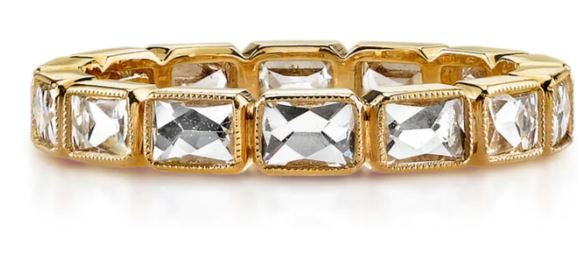The term “French Cut” in the context of diamonds refers to a particular style of diamond cutting that became popular in the early 20th century. This cut is characterised by a square or rectangular shape with truncated corners and a small table (the flat top surface of the diamond). The French Cut diamond is often used as a side stone in jewellery settings, particularly in vintage and Art Deco pieces.

Here is a brief history of the French Cut diamonds:
- Origin and Development: The French Cut diamond style emerged in the 1920s during the Art Deco era, which was known for its geometric shapes, intricate designs, and use of new cutting techniques. The French Cut was developed as a modification of the earlier single-cut diamonds, which had a similar shape but fewer facets.
- Characteristics: French Cut diamonds typically have a square or rectangular shape, with 18 facets – 17 on the crown (top) and a small table. The step-cut facets create a distinctive pattern that gives the diamond a unique and elegant appearance. The truncated corners add to the overall geometric aesthetic.
- Popularity: French Cut diamonds gained popularity during the Art Deco period and remained fashionable throughout the early to mid-20th century. These diamonds were often used as side stones to complement larger centre stones in engagement rings, earrings, and other jewellery.
- Evolution: Over time, cutting techniques evolved, and new styles such as the emerald cut and Asscher cut gained popularity. While French Cut diamonds are no longer as widely used in contemporary jewellery, they continue to be appreciated for their vintage charm and are sought after by collectors and those who appreciate antique jewellery.
- Modern Variations: While the classic French Cut may not be as common in modern jewellery, there are variations and interpretations that blend traditional charm with contemporary designs. Some jewellers may incorporate elements of the French Cut into custom pieces or use modern cutting techniques to create a similar aesthetic.

In summary, the French Cut diamond has a history rooted in the Art Deco era, characterised by its unique square or rectangular shape with truncated corners and a small table. While it may not be as prevalent in modern jewelry, its influence can still be seen in vintage and antique pieces, and the style continues to hold a certain nostalgic appeal.




